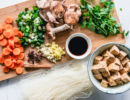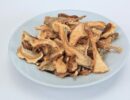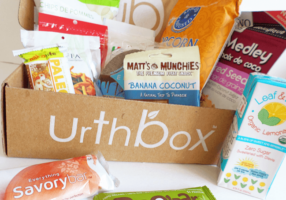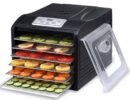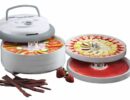Any flower that people may safely eat is considered edible. Aside from enjoying these natural decorative elements and giving sufficient oxygen into your surroundings, better cultivate something that you can add to your cooking someday.
Take your gardening to another level with edible flowers that you can grow indoors. Aside from adding life and vibrancy to your home, you will be cultivating something that you can enjoy munching and chewing in the future.
Edible flowers have gained appeal as creative and original compositions for the vegan diet and culinary world; they are added to recipes to bring glamorous unique tastes, scents, and adornment. Edible flowers have strong and distinctive aromas, textures, and colours.
They can be added to salads or consumed as a major ingredient in a particular recipe. Mind that some of these plants only have the petals as edible; the rest of the plant is not.
1. Hibiscus
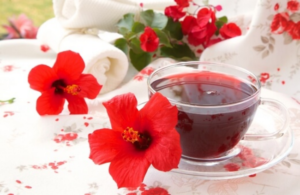
More than its reputation as a highly lovely blossoming flower that you can decorate any corner of your home, Hibiscus also has culinary and medicinal capacities. This flower has a cranberry-like, zesty, and tangy acidic taste.
You may use the fresh petals of Hibiscus in fruit salads and sweets or dry the petals to create tea. It can take up to one week for them to dry completely but can be done faster if you have a food dehydrator.
This flower can also be eaten raw, pickled, and as a garnish. More than tea and garnishes, hibiscus can be an alternative to lime and parsley which can be added to tacos, quesadillas, and your favourite cocktails.
Take note that this plant may produce several yellow pollens which causes allergies and rhinitis.
Hibiscus should be placed nearby a window where sufficient amount of sunlight or sun rays hits the whole plant’s composition from its tip to the base of the pot. Maintain a room temperature not exceeding 55 degrees Celsius.
2. Chrysanthemum
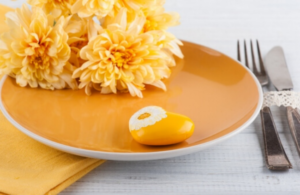
Chrysanthemum leaves, stems, and especially petals are very ideal for teas. These edible flowers are also used in Asian cuisines and Chinese dishes like stir fry recipes. They appear in a variety of hues from orange, yellow, red, and white, and have a musky peppery flavour.
Lots of light is good for chrysanthemums, but not direct sunlight. Keep them next to a window so they can take advantage of the natural light and air that comes from the outdoors.
3. Carnation
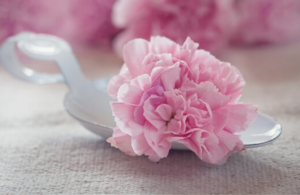
Carnation petals have a gentle nutmeg and clove combination of aromas as an aftertaste to its very lovable sweet taste. The petals should be separated from the base of the flower which gives a bitter taste. These petals are perfect for sprinkling over salads, as a garnish to cooked dishes, and as cake and pie toppings.
To make a traditional syrup that may be used as the base for ice cream, a glaze for lamb or turkey, and additives to your cocktails, steep the flowers in one cup of sugar water. In salads, make it more colourful by combining carnation petals with baby lettuce and finely dried green leaf veggies.
Before chilling, add them to aspic’s vinegar. To give them a spicy flavour, steep them in wine or cordials. Its medicinal properties include alleviating inflammation, calming the nervous system, and decreasing instances of swelling. This plant also helps in easing menopausal symptoms, menstrual cramps, and muscular strains.
Keep within an environment that does not exceed 15 to 21 degrees Celsius. This plant prefers a bright atmosphere but not direct sunlight. Make sure not to keep its soil moist, watering should be regular but in fewer amounts.
4. Marigold (*only Calendula and Tagetes)
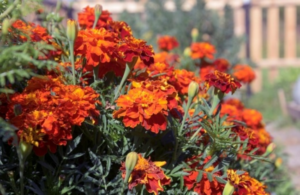
Calendula and Tagetes Marigold variants have health benefits which are sources of Lutein. They are best for garnishes and sprinkles over cakes and ice creams. Marigold can make a sumptuous tortellini soup flavour additive. Add marigold flower petals 3 minutes after turning off the fire with your favourite soups and you will have the heartiest dish with a floral aroma!
Your favourite pasta salad can be brightened up with carnation pieces in it! Marigolds are also best for making juices and teas. Simply infuse this in freshly squeezed lemon, orange juice, or honey and enjoy!
Water the potted plant consistently and make sure to drain the water thoroughly. They can grow in bright and well-air-circulated atmospheres under direct or indirect sunlight.
5. Dandelion
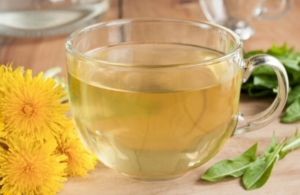
Dandelions are regarded as a weed although this flowering plant is completely edible. Their greens may be eaten raw or cooked, and their flower buds are surprisingly delicious with a tinge of honey. Do you know that you can make Dandelion patties or balls? Exciting, isn’t it?
Furthermore, you can add it with your favourite spices and herbs eggs, flour or mashed potatoes, and salt, and you can definitely munch on these salty-sweet goodies. It does not require a huge amount of maintenance, but it must get ample direct sun exposure and seldom watering.
6. Lilac
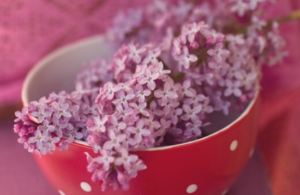
Although lilac flavours can vary, these edible flowers are typically described as generally bitter, lemony, and flowery in both flavour and fragrance. The lilac blossoms give twists to salads and summer beverages with unique bursts of colours and exciting tastes. Lilac goes well with vodka and martinis.
Infusing the lilac flowers can make sweet syrup. you can infuse them in honey, melted sugar, or garnishes in jellies. These edible flowers are also best as toppings and garnishes on tarts and cakes.
It is important to give the plant direct sun exposure at least 6 hours a day. It is best placed in a south-facing window. Maintain a moist soil for this plant by adding a saucer underneath its pot.
7. Sunflower
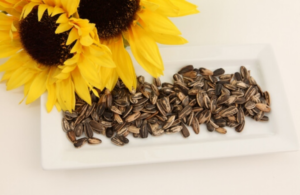
Sunflower petals are mostly used in salads and stir-fries. It can be eaten raw or cooked. Its petals, seeds, and buds have the famous nutty flavour with herbaceous notes. Sunflower seeds can be the main ingredients in cookies and cakes.
These are also great munchies as snacks and as flavourings in sautees or stir-fries together with watercress, kale, and spinach. The petals are perfect toppings for presenting your vanilla and chocolate ice cream.
You can start with three seeds and plant each in a 3 to 4 inches peat pot. The optimum drainage will be provided by a soil-less planting medium. Germination indoors typically takes 6 to 10 days. Hence, grown sunflowers, do not expose to direct sunlight for more than 5 hours a day.
Most especially, do not expose to very cold atmospheres. To keep these edible flowers looking vivid and healthy, add 1 teaspoon of sugar, 2 tablespoons of lemon juice, or vinegar to the water when watering the plant.
Check out this in-depth guide for everything you need to know to growing Sunflowers in your garden.
8. Pansies
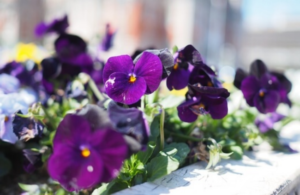
These edible blossoms have a taste that is moderately sweet with a hint of wintergreen mint. They go nicely with sweets, soups, fruit salads, and drinks. They go great with Arugula for salads. Pansies are edible from stem to sepals, the entire flower as a whole.
Whilst, if you like to beautify simple dishes like crepes or pancakes, you can top them with pansies. Candied pansies are one of the most popular recipes for these edible flowers. You need granulated sugar, egg whites, and 3 drops of vodka combined together.
Pansies love cold temperatures. Never expose them to direct sunlight, and regularly water your plants to keep the soil moist. Always get rid of dead leaves and petals to avoid them from rotting quickly.
9. Lavender
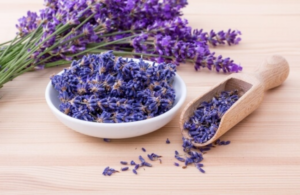
Lavenders are fragrant and have a mild flower taste. These edible flowers are mostly used for teas and sprinkled in drinks and cakes. You can also add these to your cooking to achieve a unique aroma. Lavender is perfect with blueberry recipes like blueberry mousse, cakes, cookies, tarts, and pies.
Using lavender in any dish doesn’t need to be cooked for long. You can add these edible flowers not more than one minute after cooking or putting your dessert batter for baking.
It is best to expose lavender to sunlight as much as you can. It will thrive in a south-facing window or anywhere that a large amount of light enters indoors with at least three to four hours of daily direct sunshine. To ensure regular development and flowering, rotate the container every week. Lavender only needs watering twice to thrice a week and it is better to keep its soil dry.
10. Nasturtiums
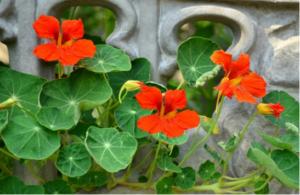
These plants may be used in salads and have peppery goodness akin to watercress. The fresh seeds may be picked and used in many dishes to replace capers. The edible flowers’ petals and leaves are also great as garnishes and for salads.
You can do your own version of pesto for pasta with nasturtium leaves. Just combine them with rock salt, garlic, olive oil, nuts (optional), and Parmesan. The leaves of this edible flowering plant can also be stuffed with meat and poultry.
Nasturtiums soil needs to be acidic to neutral, it needs more sun of at least 6 to 8 hours a day. Keep the soil drained but keep it regularly watered. They have higher maintenance as you need to trim down unnecessary sprouts and dead leaves, stems, and flowers from time to time.
Enjoy Growing These Edible Flowers in Your Garden
Planting and caring for these edible flowers to grow at home will keep you connected to nature, which is beneficial to health and wellness in some ways.
![]()






